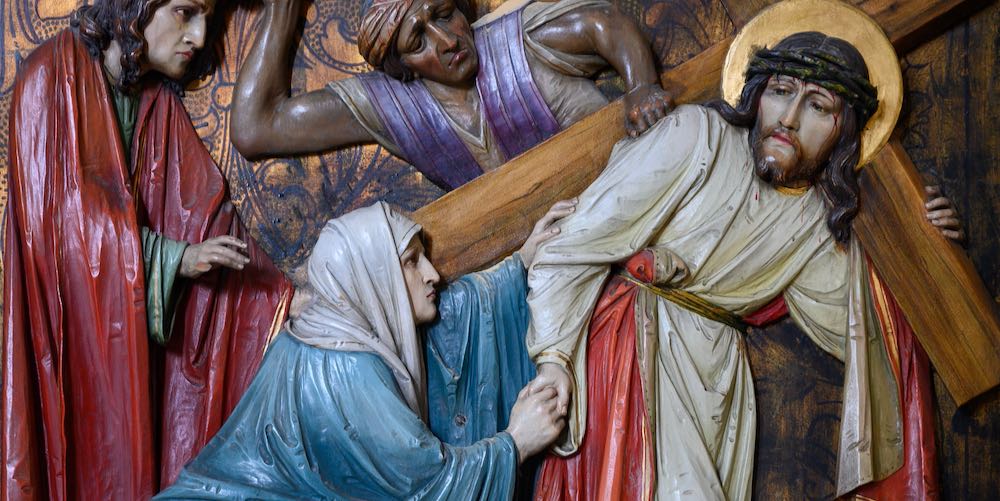Benedict always spoke of a “reason illumined by faith,” a dialogue that he believed characterized Europe at its best.
In the Face of Suffering
Still and silent, she stood the song says, sorrowing. Around her was chaos and blood; soldiers shouting orders; gawkers spitting and heckling; other death row criminals shrieking in hysterical terror. For six hours she stood, the length of time tradition has it that the man opposite her was dying of suffocation, dehydration, and multiple-organ failure due to crucifixion. Internecine political and politico-religious dynamics, along with an arguably deliberate failure of the justice system, had led her on this path to watch the dying of her son. And yet her stillness was not paralysis in the face of horrific agony. Her stillness was the determination of a courageous soul, one willing to endure the sight of her child’s suffering in order for him to do the thing he needed to do. Her silence was not a dismissal, but the acknowledgment of that suffering’s unique magnitude, and the victim’s ownership of it separate from her own tragic experience. Her suffering was not the marquee point. His was.
For six hours Mary watched her son Jesus progress through death, and for two millennia now, billions of spiritually and culturally-inclined individuals occasionally have paused to watch her watching her dying son. There’s curiosity and sympathy in that pause, and not a little perplexity. In front of the spectacle of another’s suffering, does one stay or does one go? How to differentiate between voyeurism and exploitation on the one hand, and respect and genuine compassion on the other? Above all, outside of knowing what to do with the fact of human suffering, what is it exactly that we are supposed to do with the sight of human suffering, whether the suffering of individuals or communities, or nations—not the least, of one’s own mother?
Quis est homo qui non fleret? Who is the human who would not weep, at the sight of such great suffering? It’s the reverberant question posed by the Stabat Mater, a medieval poem and hymn that’s still perhaps the most famous account of the watching of suffering. In answer to it is an initial modern confusion: Today, we do a lot of affinity weeping. Living as so many do on our social media platforms, we’ve seemingly developed a discomfiting capacity to want to claim the dividends of a tragedy not our own, as our own. We stake our claim to public attention on the grounds of an often-tenuous proximity to a tragic event—to exhibit our participation in the tragedy-pie. (Witness, in this recent pandemic, those individuals who took to Twitter and Instagram pre-vaccine to bemoan the fact that “not even Covid wanted them”; unaffected celebrities admonishing “we are all in this together” to the suddenly unemployed hoi polloi; also, the sharp rise in appetite for “disaster porn.”)
Tears today come publicly and cheaply. Yet not to be affected by a proximate suffering, not to respond to it somehow, seems hardly less reprehensible. And so again the question: What are we to do with the sight of suffering?
Politics gives no straightforward answers here. Things get complicated fast when nations feel emotionally moved to intervene out of a sense of righteousness or compassion. This is why in his Pacificus essays, Hamilton cautions that the rule of morality is not the same between governments or nations as between individuals (which is not to say that political life is less moral than private life). The scale alone differentiates it: “Existing Millions and for the most part future generations are concerned in the present measures of a government: While the consequences of the private actions of an individual, for the most part, terminate with himself or are circumscribed within a narrow compass.” Even when motivated by empathy, prudence is the cardinal virtue of political action. It’s a functional damper, when well employed, on a reactive, emotional fix-it-ness.
Religion seems more straightforward: A wide variety of creedal faiths have an array of answers to human suffering, in the form of specific traditions and social behaviors, pat catechetical definitions, pastoral guidance, or esoteric treatises. Often there is a theme of acceptance and patience. But even here there is a real struggle to make sense of the bare fact of suffering. What does human suffering imply about the reality of a Creative Divinity, benevolent or otherwise? What might that mean for human beings?
More capacious than either politics or religion is art. For most human beings, art seems to bridge these two realms and the spirit and heart within each individual. Out of everything else, art seems uniquely to allow the suffering just to be: To be seen and to be experienced; to be sat with, but also moved through, in a manner that can be both respectful and compassionate. Music above all seems to have this capability—which perhaps explains why, in the instance of Jacopone da Todi’s enduringly famous twenty-verse poem Stabat Mater, over 600 secular composers from Europe to Africa to Asia have continued to find a rich vein of source material to mine.
Music creates a necessary bridge between the closely-held personal experience of suffering, the encountering of the sight of another’s suffering, and the communal appreciation of its occurrence. Music, in its performance, is necessarily external and public, but it still expresses profoundly personal emotions.
The initial phenomenon of the Stabat Mater is Simeon’s prophecy to Mary in Luke’s Gospel, foretelling her witness of her son’s brutal death and her central role in humanity’s reckoning thereafter.
The Stabat Mater, in its poetic origins, is a prayer, thought to originate from Franciscan sources in the 13th century in parallel with the tradition of St. Francis of Assisi’s mysticism, whose central feature was an immersion of the individual in the especially physical sufferings of the Christ. (Its authorial origins are contested, as later research has uncovered what appeared to be a first sighting of the hymn in a Dominican convent in Bologna, Italy). The poem is voiced from the reader’s point of view, fixed initially on the figure of the standing and still mother. Acknowledging her suffering, the observer-reader spontaneously asks:
Can the human heart refrain
From partaking in her pain,
In that Mother’s pain untold?”
The reply is a simple negative. The heart cannot refrain. There must be a response. What follows is a request to that suffering mother, asking permission to participate in her and her son’s suffering in order to experience, under her protective guidance, a redemptive cleansing and ultimately, a glorious salvation. It’s a chance at a larger-than-life catharsis. Even the poem-prayer bridges the personal and the communal in uniting each reciter to (in Christian parlance) the Church Militant, the Church Suffering, and the Church Triumphant—to humanity both past and future. But here this activity is mainly observational rather than truly interactive. We never once hear a verbal response, nor, in da Todi’s version, are we ever granted access to the inmost thoughts of Mary’s heart.
“Thy own soul a sword shall pierce, that, out of many hearts, thought may be revealed.” To Mary is the actual pain; to us, the subsequent contemplations. The initial phenomenon of the Stabat Mater is Simeon’s prophecy to Mary in Luke’s Gospel, foretelling her witness of her son’s brutal death and her central role in humanity’s reckoning thereafter. The dramatic pronouncement already is communal, even theatrical. Indeed, there’s a nod to the central fact of the “spectacle” of the Stabat Mater in the very thematic origins of the poem, in their relation to the dramatic conventions of the Middle Ages. Very popular in medieval Germany and Italy was a type of theater devoted to the performance of passion plays. Marienklagen or Maria laments were one group of dramas that emphasized the unique role of Christ’s mother in the Passion (especially as depicted in the Gospel according to St. John) but also across the New and Old Testaments. Such plays were usually performed during the Lenten penitential season, in synch with the liturgical calendar of Christ’s birth, passion, death, and resurrection. But these were secular events—meant for a large and popular audience. However edifying in authorial intent and message, the plays were undeniably also entertainment.
Perhaps it’s unsurprising that this element of artistic entertainment is only ever magnified. As Western music developed away from sacred-only formulations such as Gregorian chant, and toward polyphony and then complex choral and orchestral pieces for secular consumption, the prayerful words of the Stabat Mater increasingly seem to have paled in importance compared to the melodies, harmonies—and eventually, dramatic atmosphere—in which composers have suspended them, enthralled by the enduring drama of the tragic spectacle. Surveying eight centuries of musical formulations of the Stabat Mater, we see that the contemplative ethos of the supernatural drama comes to the fore in Josquin Desprez (1480), Alonzo de Alba (1510) and Palestrina’s (1590) Stabats. Later versions show considerably more creative adaptation, from the “Sturm und Drang” florid, yet classical stylings of Franz Joseph Hayden’s (1767) oratorio version to the rambunctious liturgical opera of Giacchino Rossini (1842), or the Il Trovatorian tragic, dramatic stylings of Verdi (1898). Modern composers, too, have been fascinated by the Stabat, as we see in the grief-filled sacred and profane clashes of Francis Poulenc (1950), or Nicola Piovani’s cinematic recitative subsumed within a framework of class and race (1998). The multi-lingual, bluesy lullaby of Cameroonian Francis Bebey (1990) offers another interpretation, and we even see the Stabat as an expression of the “planetary restlessness” of television host and singer-songwriter Franco Simone in his symphonic rock opera cum music video production (2015).
Dvorak’s Stabat, composed in the midst of the unimaginable grief of the successive loss of his three little children, binds him to America.
The differences are obvious, and sometimes cringeworthy. While some today do seem to equate the cause of environmental justice to the supernatural drama of human salvation, the intellectual horizon of Canadian activist Bruce Cockburn’s 2017 Stab at Matter parody (wordplay? interpretation?) of the Stabat Mater is incredibly diminished from that of say, Giovanni Battista Pergolesi’s much-beloved version (1736), famously composed on that composer’s literal deathbed as he succumbed to tuberculosis, still in the prime of life. (Even the hardly-devout Jean Jacques Rousseau reportedly thought Pergolesi’s opening movement was “the most perfect and touching duet to come from the pen of any composer.”) Religious believers may not appreciate the transition from the tender, yet human modesty of Antonio Vivaldi’s 1712 Stabat to Stefaan Vanheertum’s nearly opposite reduction of the same theme to “feelings like disbelief, pain, anger, despair” at “young refugees drowned during the crossing of the Mediterranean.”
Even so, across the hundreds of known musical versions of the Stabat Mater, the most remarkable thing is, in fact, the centrality of the original prayer that formed, seemingly spontaneously, before the spectacle of Mary’s still and silent figure. That prayer has taken many forms over the centuries—now veering more toward the mystical and contemplative, now more toward the emotional and supplicative; now more communal, and now more individual. Prayer has always been of many kinds. But it has always been a lifting up of the heart.
Eia Mater, fons amoris
Original translation
Me sentire vim doloris
Fac ut tecum lugeam.
Oh Mother, fount of love
Me make feel the strength of sorrow
that I with you may grieve.
Mary’s standing at Calvary and afterward was of course the longest such moment. Her sorrow has a strength; it is a strength; she is strong with it. She stands. In musical terms, it is Antonín Dvořák’s Stabat Mater (1877) that commands the longest performance time, at 90 minutes, and that requires the greatest amount of instruments, musicians, and singers. (At its British premiere at the Royal Albert Hall, under Dvorak’s own baton, there were over 600 singers alone.) It’s the piece that so profoundly moved British audiences that it paved the Czech composer’s eventual way to America. Dvorak’s Stabat, composed in the midst of the unimaginable grief of the successive loss of his three little (and at the time, his only) children, binds him to America, which is a poetic and poignant fact for me as an American lover of music. What are those words we’ve inscribed around the base of the Statue of Liberty in New York harbor? They, and America, are meant to be also a solace.
In grieving notes, Dvořák offers solace. With seriousness and without affectation, Dvořák offers up ten movements that perfectly arch through a succession of emotions to resolution, with the initial lacrimosa, the tears, repeated in the concluding paradisi, the glory of paradise granted to a soul. The orchestra’s introductory undulations are Mary’s falling tears, and we know we are the ones lamenting this sight, and that the lamentation will not be some uncontrollable flailing, but a meditation on the multiple aspects of her grief, and the desire to share her suffering and wrest some solace for her.
We do not only lament here, nor do we have to lament alone. Dvořák’s private suffering from the death of his children is woven through his song within Mary’s individual, yet public suffering at the death of her son. Through the musical devices of singers, chorus, and symphonic orchestra, showcasing da Todi’s centuries-old poem, Dvořák gently yet emphatically makes the case that grieving with others reinforces the human community, reducing some of the bitterness of pain. By placing his final “amen” in the D-major key—the key Bach and Beethoven used to depict heaven— Dvořák at least alludes to the possibility of a type of (infinitely more fragile, to be sure) heaven or blessedness that societies bound by space, time, and mortality can aim to achieve even in the here and now. Aristotle called it “concord,” and predicated it on individual human beings communing with each other in a society small enough for individuals to be seen. The pre-Incarnation Ancients may not have been sanguine about the role that a grieving together of society can play toward achieving such concord, but that belief and hope directly animates the entire history, artistic and otherwise, of the Stabat Mater.
Dvořák, as so many of his fellow composers do, uses his musical art to help the community of his musicians and his listeners achieve a parallel ending. Having seen and participated in the act of the spectacle of sorrowing, through his Stabat Mater he as artist places us in a living portrait of grace and concord, enabling us to see and participate in this meditation. By allowing us the space to see, sit with, and move through a lamentable suffering, he enables us to reconcile ourselves to its presence—perhaps even, to stand courageously in the sight of it. That resolution can extend outside of the performance hall and even to the levels of whole societies and nations. I’d like to think that perhaps one of the reasons that Dvořák’s Stabat has had such a powerful impact in America was that it was introduced when the United States was still reeling from the horrific violence and death of the Civil War. Compared to its European cousins, the young nation had little experience with this—and even today, it has been blessed with relatively little experience of this kind of horror. If his Stabat was a solace then, it still can be so for us today, as we struggle mightily in our culture and politics with the question of whether, and to what extent, the United States still might be a solace to suffering masses of humanity currently repressed by cruel governments.
Still and silent, she stood the song says, sorrowing. To Mary is the actual suffering; to us, the subsequent contemplations. The seeing of suffering in fact turns out to be something crucial to us in our humanness. But we first have to pause, to see the suffering. Finally, what the music, the art, and the spectacle of that suffering mother gift us is not merely the human importance of pausing at the sight of suffering. They gift us also this insight: that it is no less important to allow our own suffering to be seen, to soften some of its bitterness. Then, we too can stand, despite our sorrowing.



